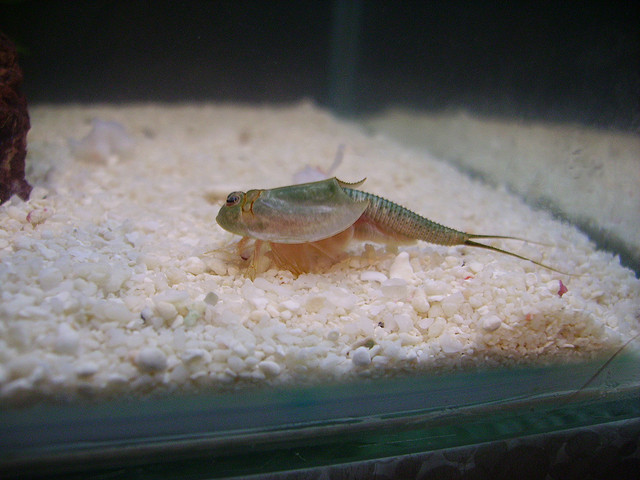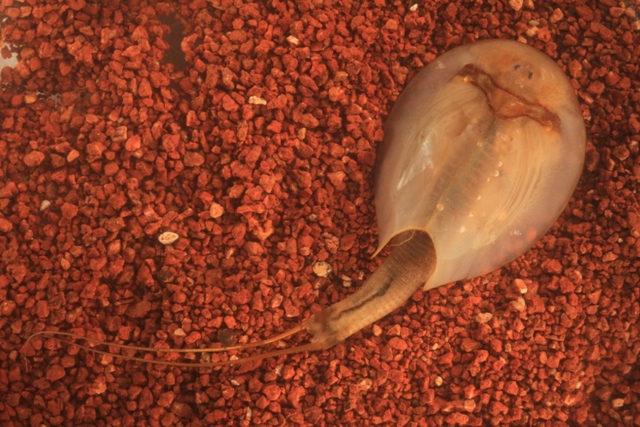Phylum Arthropoda
Subphylum Crustacea
Class Branchiopoda
Order Notostraca
Common name: shield shrimps, tadpole shrimps, triops
Overview
Notostraca, or shield, tadpole shrimps or known by the genus name �Triops�are a small group of aquatic crustaceans. Notostracans get their common names from the broad, plate-like carapace that covers most of their elongate body which is composed of numerous ring-like segments finishing with a long tail. �Triops� means �three eyes� and the front of the carapace has a pair of sessile compound eyes and in between, a naupliar eye, which is retained in the adult. Behind the three eyes is an unusual four-celled organ, the function of which is uncertain. The antennules are small, uniramous and poorly segmented, and the antennae are smaller, unsegmented or absent. The mandibles are quite large, with many tooth-like projections. The first eleven body segments make up the thorax, and each bears a pair of paddle-like pereopods called phyllopods (leaf-shaped appendages). These legs have 6 lobes on the inner side that push the food towards the mouth; on the outer side is one large swimming lobe and one breathing lobe, modified into a gill. The first trunk appendage possesses several elongated extensions that protrude from beneath the carapace and may be mistaken for antennae. In females, the last pair of swimming lobes is modified into round ovisacs (egg capsules). The number of legs behind the thorax varies greatly, and may be up to 70 as each segment, from the thirteenth onwards, may bear 4 to 6 pairs of legs. The legs gradually become smaller from front to back, while the hind-most segments are free of legs, forming a long and very mobile tail (telson) that bears two long segmented uropods (furcae). Adult notostracans range in size from 3-11 cm in length and from black and brown to blue/green with a variety of patterned carapaces.
Distribution and diversity
Notostracans can be found worldwide on every continent except Antarctica from subarctic to tropical regions in ephemeral fresh, brackish or saline waters. However, despite such a wide distribution there is only a single family with around 16 species in 2 recognised genera Lepidurus (monophyletic) and Triops (polyphyletic). Some species are widespread while others are highly restricted in their distribution. Each genus is represented by a single species in Australia: T. australiensis australiensis (endemic) and L. apus viridis (an endemic subspecies; L. apus is cosmopolitan). In the north of the continent and the drier inland areas, only T. australiensis australiensis is found. In the southeast, both species occur but their ranges are mostly distinct, with some overlap in NSW and northern Victoria.
Life cycle
There are males and females present in most populations around the world, although it is likely that all individuals are to some degree hermaphroditic. In Northern Europe and America males rarely occur, with populations being female or hermaphroditic. In warmer regions, including Australia, the sexes are more balanced and in some tropical populations, males may even outnumber females. Both fertilised and unfertilised eggs are carried in the female's ovisacs on the 11th pair of pereopods (thoracic legs) until mature when they are released to settle in the sediment in the bottom of the pool. Some hatch immediately while others form thick shells (cysts) and remain in the soil after the pool dries, withstanding freezing and drought, remaining viable for up to 20 years. Wind and animals easily carry these desiccated eggs over great long distances. Most notostracans hatch as late naupliar stage larvae (meta-nauplius), though some species hatch as unsegmented nauplii. Development into adults is very rapid (2-3 weeks) via a large number of moults (up to 40 in some species). Their lifespan is around 50-90 days depending on how long the water lasts. Desiccated eggs can begin to hatch within three days of the pools filling again. In northern and inland Australia, T. australiensis australiensis hatches at any time of year, given suitable pools of water. In the southeast of the continent, adult T. australiensis australiensis and L. apus viridis have only been recorded in winter and early spring.
Feeding
Notostracans are opportunistic omnivorous filter feeders, grazers and predators. They dig around in the mud using the frontal part of their shield. Their beating phyllopods form a current that carries food particles from the sediment at the bottom to their mouth. Notostracans also graze on water plants and will catch and eat anything smaller (or weaker) than themselves, including other crustaceans (such as anostracans cladocerans, ostracods and copepods), worms, chironomid and mosquito larvae, frog eggs and tadpoles. Cannibalism of smaller or recently moulted conspecifics is also common. The inward-pointing spikes at the base of each front leg are used to grab larger food particles and pass it from one leg to another forward to the mouth.
Ecology
Most notostracans are adapted to exploiting ephemeral water bodies and are correspondingly short-lived. Their rapid life cycle and desiccation resistant, wind-dispersed eggs is a likely reason why the group is so widely dispersed. The other is their geological longevity. Notostracans external morphology has not changed since the Triassic appearance around 220 million years ago of the widespread, extant species, Triops cancriformis. No other living animal species is known to have existed so long ago and as such, are referred to as �living fossils�. Notostracans typically live near the bottom of pools, where they move with their ventral side down searching for food. However, lack of oxygen can force them to swim upside-down with their gills close to the surface of the water. As they typically occur in pools without fish and usually eat anything smaller than themselves, notostracans are often the top predators in their temporary pools. They are also an important food source for migratory birds. In the USA and Europe several species are considered endanged because of limited distribution and habitat loss. However, when populations of some Triops are very large, they are considered pests in rice paddies as they damage young rice plants while digging in the sediment for food. In contrast, Triops spp. have also been used by some farmers in Japan as biological agents of weeds in rice paddies. They are also considered to be a potential biological control agent for disease-bearing mosquitoes. Similar to �sea monkeys� (Anostraca), some species are sold as short-lived aquarium pets; T. australiensis australiensis are marketed as �billabong bugs� in Australia.


Triops australiensis
Image credit: � Brian Timms, Honorary Research Associate,
Australian Museum, Sydney. Used with permission.









